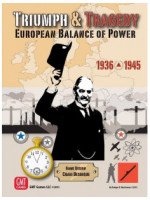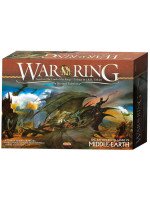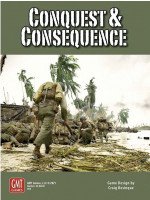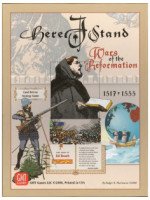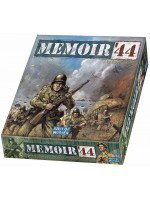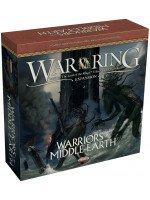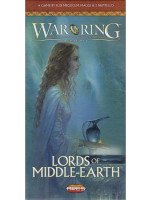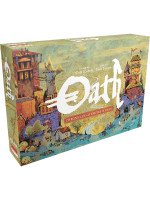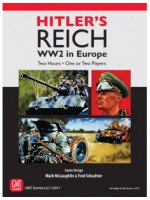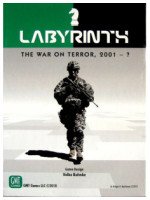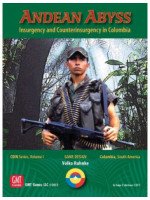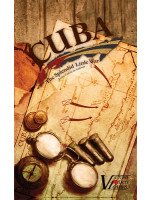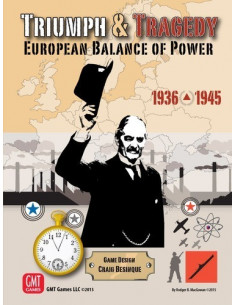
Triumph & Tragedy: European Balance of Power
Triumph & Tragedy is a geopolitical strategy game for 3 players (also playable by 2) covering the competition for European supremacy during the period 1936-45 between Capitalism (the West) Communism (the Soviet Union) and Fascism (the Axis). It has diplomatic economic technological and military components and can be won by gaining economic hegemony or technological supremacy (A-bomb) or by vanquishing a rival militarily.
The 22 x 34 area map covers Eurasia to India and the Urals plus the Americas. Military units are 5/8" blocks of 7 types (Infantry/Tank/Fortress/AirForce/Carrier/Fleet/Submarine) in 7 different colors (Germany/Italy/Russia/Britain/France/USA/Neutral). The mix of over 200 blocks allows great flexibility of force composition. There is a 55-card Action deck and a 55-card Investment deck plus 30 Peace Dividend chits and 110 markers of various types.
The game starts in 1936 with all 3 Great Powers virtually disarmed: Germany has repudiated the Versailles Peace Treaty initiating an arms race in Europe. With blocks the nature of military buildups remain unknown to rivals unless/until military conflict breaks out. The game may end peacefully or there may be war. There are game sanctions for attacking neutral minors or declaring war on an opponent and rewards for remaining peaceful (you get a Peace Dividend chit of value 0-2 for every year you remain at Peace).
You can win peacefully by:
• Economic Hegemony (total of Production + secret Peace Dividend values + Atomic Research is the greatest in 1945 or reaches 25 at any time) OR
• Technological Supremacy (build the A-bomb which takes 4 stages and be able to deliver it to a Main Capital).
If there is war you can still win by either of the above methods (with extra Economic Hegemony victory points available) or by:
• Military Victory (capture TWO enemy capitals out of nine: each player controls three).
Economic production underlies all forms of power in the game. Production is the LEAST of controlled Population (cities) controlled Resources and Industry (which starts low and can be built up with Investment cards) except that Resources can be ignored if at Peace.
Powers can spend their current economic Production on either:
• Military units (new 1-step units or additional steps on existing units) OR
• Action cards which have Diplomatic values (to gain Population and Resources without conflict) and a Command value (to move military units) OR
• Investment cards which have Technological values (to enhance unit abilities) and a Factory value (the only way to increase Industry levels).
Building a unit step or buying a card costs 1 Production. Simple. You can’t inspect cards bought until after you have spent all Production.
Initially the Axis economy is Population/Resource limited but ahead in [war] Industry while the West and Russia are Industry-limited with adequate empires of Population and Resources. Throttling/limiting rival economies by denial of Population/Resources is a key form of competition. In peacetime this is primarily done via Diplomacy committing Action cards to gain control of minor nations and their Population/Resources or to deny or reduce Rival control of them. At war this can be done more directly by military conquest on land by Naval/Submarine blockade of trade routes at sea and by Strategic Bombing of enemy Industry by air forces.
The early phase of the game tends to revolve around:
• Diplomatic infighting (using Action cards) to gain minor nations (Czech Rumania etc) for their Population and Resources and
• Industrial buildup (via Investment cards) with
• Military buildups (with the nature of forces being built being unknown to opponents)
• Technology advancement (also via Investment cards) and some
• Military operations (using Action cards for Command) which can include Violating (attacking) neutral minors to gain Population/Resources when Diplomacy fails.
If the game continues peacefully due to imposing defenses or player inclination pressure builds as players approach a Production of 20 as secret Peace Dividend chits may take someone over the 25 Victory threshold. Or players may succeed in developing the Atomic Bomb and steal a victory that way.
At some point however one Power (seeing opportunity or necessity) may Declare War on another. The victim gets immediate economic benefits in reaction but military reality comes to the forefront from this point onward. The third party may well continue its economic development in peace. Or not.
Unit movement is by Command card which specifies a Command Priority letter that determines order of movement/combat and a Command Value number that determines the maximum number of units that can be moved. Command cards are only valid during one specified Season (Spring/Summer/Fall) so a variety of Command cards in one’s hand is necessary for a Power to be a
- Deze editie is in het Engels.
- Geschikt voor 2 - 3 spelers.
- Je bent ongeveer 360 min. aan het spelen.
- Vanaf 12 jaar is dit spel te spelen.
Triumph & Tragedy: European Balance of Power aanbiedingen:
-
- Bezorgkosten: € 6,00
- Levertijd: Voor 16:00 besteld, volgende werkdag in huis.
Op basis van 2.482 ervaringen op het toonaangevende Boardgamegeek.com
Dit spel wordt aangeraden voor (in %):
Triumph & Tragedy is a geopolitical strategy game for 3 players (also playable by 2) covering the competition for European supremacy during the period 1936-45 between Capitalism (the West) Communism (the Soviet Union) and Fascism (the Axis). It has diplomatic economic technological and military components and can be won by gaining economic hegemony or technological supremacy (A-bomb) or by vanquishing a rival militarily.
The 22 x 34 area map covers Eurasia to India and the Urals plus the Americas. Military units are 5/8" blocks of 7 types (Infantry/Tank/Fortress/AirForce/Carrier/Fleet/Submarine) in 7 different colors (Germany/Italy/Russia/Britain/France/USA/Neutral). The mix of over 200 blocks allows great flexibility of force composition. There is a 55-card Action deck and a 55-card Investment deck plus 30 Peace Dividend chits and 110 markers of various types.
The game starts in 1936 with all 3 Great Powers virtually disarmed: Germany has repudiated the Versailles Peace Treaty initiating an arms race in Europe. With blocks the nature of military buildups remain unknown to rivals unless/until military conflict breaks out. The game may end peacefully or there may be war. There are game sanctions for attacking neutral minors or declaring war on an opponent and rewards for remaining peaceful (you get a Peace Dividend chit of value 0-2 for every year you remain at Peace).
You can win peacefully by:
• Economic Hegemony (total of Production + secret Peace Dividend values + Atomic Research is the greatest in 1945 or reaches 25 at any time) OR
• Technological Supremacy (build the A-bomb which takes 4 stages and be able to deliver it to a Main Capital).
If there is war you can still win by either of the above methods (with extra Economic Hegemony victory points available) or by:
• Military Victory (capture TWO enemy capitals out of nine: each player controls three).
Economic production underlies all forms of power in the game. Production is the LEAST of controlled Population (cities) controlled Resources and Industry (which starts low and can be built up with Investment cards) except that Resources can be ignored if at Peace.
Powers can spend their current economic Production on either:
• Military units (new 1-step units or additional steps on existing units) OR
• Action cards which have Diplomatic values (to gain Population and Resources without conflict) and a Command value (to move military units) OR
• Investment cards which have Technological values (to enhance unit abilities) and a Factory value (the only way to increase Industry levels).
Building a unit step or buying a card costs 1 Production. Simple. You can’t inspect cards bought until after you have spent all Production.
Initially the Axis economy is Population/Resource limited but ahead in [war] Industry while the West and Russia are Industry-limited with adequate empires of Population and Resources. Throttling/limiting rival economies by denial of Population/Resources is a key form of competition. In peacetime this is primarily done via Diplomacy committing Action cards to gain control of minor nations and their Population/Resources or to deny or reduce Rival control of them. At war this can be done more directly by military conquest on land by Naval/Submarine blockade of trade routes at sea and by Strategic Bombing of enemy Industry by air forces.
The early phase of the game tends to revolve around:
• Diplomatic infighting (using Action cards) to gain minor nations (Czech Rumania etc) for their Population and Resources and
• Industrial buildup (via Investment cards) with
• Military buildups (with the nature of forces being built being unknown to opponents)
• Technology advancement (also via Investment cards) and some
• Military operations (using Action cards for Command) which can include Violating (attacking) neutral minors to gain Population/Resources when Diplomacy fails.
If the game continues peacefully due to imposing defenses or player inclination pressure builds as players approach a Production of 20 as secret Peace Dividend chits may take someone over the 25 Victory threshold. Or players may succeed in developing the Atomic Bomb and steal a victory that way.
At some point however one Power (seeing opportunity or necessity) may Declare War on another. The victim gets immediate economic benefits in reaction but military reality comes to the forefront from this point onward. The third party may well continue its economic development in peace. Or not.
Unit movement is by Command card which specifies a Command Priority letter that determines order of movement/combat and a Command Value number that determines the maximum number of units that can be moved. Command cards are only valid during one specified Season (Spring/Summer/Fall) so a variety of Command cards in one’s hand is necessary for a Power to be a
| Naam | Triumph & Tragedy: European Balance of Power |
|---|---|
| EAN | 817054010851 |
| Taal | Engels |
| Aantal spelers | 2 - 3 |
| Speeltijd | 360 min. |
| Minimale leeftijd | 12 jaar |
| Uitgever | GMT Games |

